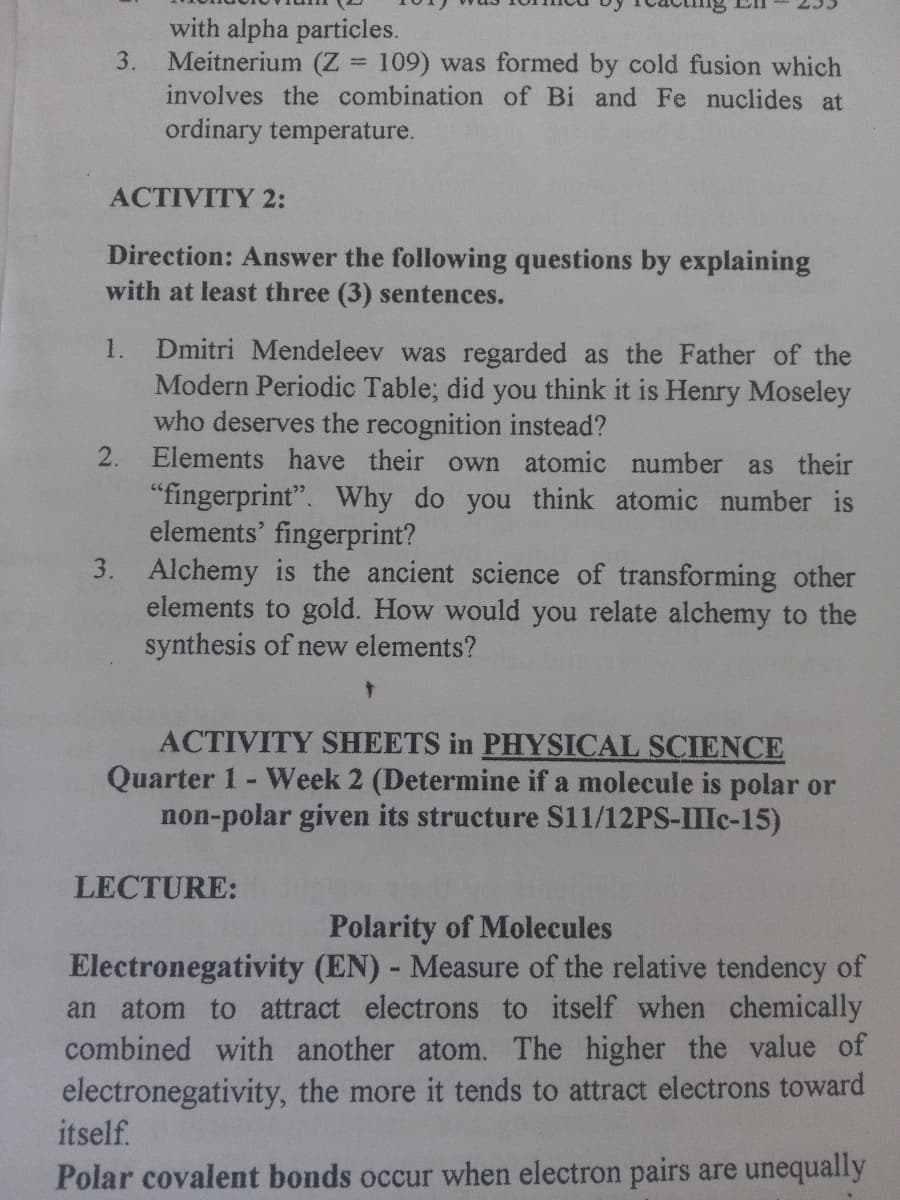with alpha particles. 3. Meitnerium (Z 109) was formed by cold fusion which involves the combination of Bi and Fe nuclides at ordinary temperature. ACTIVITY 2: Direction: Answer the following questions by explaining with at least three (3) sentences. 1. Dmitri Mendeleev was regarded as the Father of the Modern Periodic Table; did you think it is Henry Moseley who deserves the recognition instead? Elements have their own atomic number as their 2. "fingerprint". Why do you think atomic number is elements' fingerprint? 3. Alchemy is the ancient science of transforming other elements to gold. How would you relate alchemy to the synthesis of new elements? ACTIVITY SHEETS in PHYSICAL SCIENCE Quarter 1- Week 2 (Determine if a molecule is polar or non-polar given its structure S11/12PS-IIIC-15) LECTURE: Polarity of Molecules Electronegativity (EN) - Measure of the relative tendency of an atom to attract electrons to itself when chemically combined with another atom. The higher the value o: electronegativity, the more it tends to attract electrons towarc itself. Polar coyalent bonds occur when electron pairs are unequally
with alpha particles. 3. Meitnerium (Z 109) was formed by cold fusion which involves the combination of Bi and Fe nuclides at ordinary temperature. ACTIVITY 2: Direction: Answer the following questions by explaining with at least three (3) sentences. 1. Dmitri Mendeleev was regarded as the Father of the Modern Periodic Table; did you think it is Henry Moseley who deserves the recognition instead? Elements have their own atomic number as their 2. "fingerprint". Why do you think atomic number is elements' fingerprint? 3. Alchemy is the ancient science of transforming other elements to gold. How would you relate alchemy to the synthesis of new elements? ACTIVITY SHEETS in PHYSICAL SCIENCE Quarter 1- Week 2 (Determine if a molecule is polar or non-polar given its structure S11/12PS-IIIC-15) LECTURE: Polarity of Molecules Electronegativity (EN) - Measure of the relative tendency of an atom to attract electrons to itself when chemically combined with another atom. The higher the value o: electronegativity, the more it tends to attract electrons towarc itself. Polar coyalent bonds occur when electron pairs are unequally
Chemistry for Engineering Students
4th Edition
ISBN:9781337398909
Author:Lawrence S. Brown, Tom Holme
Publisher:Lawrence S. Brown, Tom Holme
Chapter14: Nuclear Chemistry
Section: Chapter Questions
Problem 14.48PAE
Related questions
Question
What is the real answers

Transcribed Image Text:with alpha particles.
Meitnerium (Z
involves the combination of Bi and Fe nuclides at
3.
= 109) was formed by cold fusion which
ordinary temperature.
ACTIVITY 2:
Direction: Answer the following questions by explaining
with at least three (3) sentences.
Dmitri Mendeleev was regarded as the Father of the
Modern Periodic Table; did you think it is Henry Moseley
who deserves the recognition instead?
2. Elements have their own atomic
1.
number as their
"fingerprint". Why do you think atomic number is
elements' fingerprint?
3. Alchemy is the ancient science of transforming other
elements to gold. How would you relate alchemy to the
synthesis of new elements?
ACTIVITY SHEETS in PHYSICAL SCIENCE
Quarter 1- Week 2 (Determine if a molecule is polar or
non-polar given its structure S11/12PS-IIIC-15)
LECTURE:
Polarity of Molecules
Electronegativity (EN) - Measure of the relative tendency of
an atom to attract electrons to itself when chemically
combined with another atom. The higher the value of
electronegativity, the more it tends to attract electrons toward
itself.
Polar covalent bonds occur when electron pairs are unequally
Expert Solution
This question has been solved!
Explore an expertly crafted, step-by-step solution for a thorough understanding of key concepts.
This is a popular solution!
Trending now
This is a popular solution!
Step by step
Solved in 4 steps

Knowledge Booster
Learn more about
Need a deep-dive on the concept behind this application? Look no further. Learn more about this topic, chemistry and related others by exploring similar questions and additional content below.Recommended textbooks for you

Chemistry for Engineering Students
Chemistry
ISBN:
9781337398909
Author:
Lawrence S. Brown, Tom Holme
Publisher:
Cengage Learning

Principles of Instrumental Analysis
Chemistry
ISBN:
9781305577213
Author:
Douglas A. Skoog, F. James Holler, Stanley R. Crouch
Publisher:
Cengage Learning

Chemistry & Chemical Reactivity
Chemistry
ISBN:
9781133949640
Author:
John C. Kotz, Paul M. Treichel, John Townsend, David Treichel
Publisher:
Cengage Learning

Chemistry for Engineering Students
Chemistry
ISBN:
9781337398909
Author:
Lawrence S. Brown, Tom Holme
Publisher:
Cengage Learning

Principles of Instrumental Analysis
Chemistry
ISBN:
9781305577213
Author:
Douglas A. Skoog, F. James Holler, Stanley R. Crouch
Publisher:
Cengage Learning

Chemistry & Chemical Reactivity
Chemistry
ISBN:
9781133949640
Author:
John C. Kotz, Paul M. Treichel, John Townsend, David Treichel
Publisher:
Cengage Learning

Chemistry & Chemical Reactivity
Chemistry
ISBN:
9781337399074
Author:
John C. Kotz, Paul M. Treichel, John Townsend, David Treichel
Publisher:
Cengage Learning

Principles of Modern Chemistry
Chemistry
ISBN:
9781305079113
Author:
David W. Oxtoby, H. Pat Gillis, Laurie J. Butler
Publisher:
Cengage Learning

Chemistry by OpenStax (2015-05-04)
Chemistry
ISBN:
9781938168390
Author:
Klaus Theopold, Richard H Langley, Paul Flowers, William R. Robinson, Mark Blaser
Publisher:
OpenStax